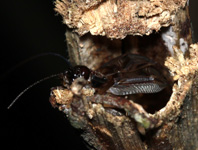Abstract
Pararhagadochir is a South American genus of Archembiidae that can be identified by its anterior margin of submentum strongly concave, caudal process of the 10th left hemitergite forked, with internal tip seemingly a hook and the external tip a flat lobe, both tips always shorter than the width of 10th left hemitergite. Six species are recorded in Brazil, being distributed in all regions. In this work, Pararhagadochir noronhensis sp. nov. is described from the archipelago of Fernando de Noronha, Brazil.
References
Iwanaga, K. & Tojo, S. (1986) Effects of juvenile hormone and rearing density on wing dimorphism and oöcyte development in the brown planthopper, Nilaparvata lugens. Journal of Insect Physiology, 32 (6), 585–590.
https://doi.org/10.1016/0022-1910(86)90076-4
Lit, I.L. Jr. & Lucañas, C.C. (2014) Are webspinners (Embioptera) really rare in the Philippines? Preliminary answers from taxonomic account and review of previous terrestrial arthropod surveys. Philippine Journal of Systematic Biology, 8, 82–92.
Miller, K.B., Hayashi, C., Whiting, M.F., Svenson, G.J. & Edgerly, J.S. (2012) The phylogeny and classification of Embioptera (Insecta). Systematic Entomology, 37 (3), 550–570.
https://doi.org/10.1111/j.1365-3113.2012.00628.x
Rafael, J.A., Limeira-de-Oliveira, F., Hutchings, R.W., Miranda, G.F.G., Neto A.M.S., Somavilla, A., Camargo, A., Asenjo, A., Pinto, A.P., Bello, A.M., Dalmorra, C., Mello-Patiu, C.A., Carvalho, C.J.B., Takiya, D.M., Parizotto, D.R., Marques, D.W.A, Cavalheiro, D.O., Mendes, D.M.M., Zeppelini, D., Carneiro, E., Lima, E.F.B., Lima, E.C.A., Godoi, F.S.P., Pessoa, F.A.C., Vaz-de-Mello, F.Z., Sosa-Duque, F.J., Flores, H.F., Fernandes, I.O., Silva-Júnior, J.O., Gomes, L.R.P., Monné, M.L., Castro, M.C.M, Silva, M.P.G., Couri, M.S., Gottschalk, M.S., Soares, M.M.M., Monné, M.A., Rafael, M.S., Casagrande, M.M., Mielke, O.H.H., Grossi, P.C., Pinto, P.J.C., Bartholomay, P.R., Sobral, R., Heleodoro, R.A., Machado, R.J.P., Corrêa, R.C., Hutchings, R.S.G., Ale-Rocha, R., Santos, S.D., Lima, S.P, Mahlmann, T., Silva, V.S. & Fernandes, D.R.R. (2020) Insect (Hexapoda) diversity in the oceanic archipelago of Fernando de Noronha, Brazil: updated taxonomic checklist and new records. Revista Brasileira de Entomologia, 64 (3), e20200052.
https://doi.org/10.1590/1806-9665-RBENT-2020-0052
Ross, E.S. (1972) New South American Embioptera. Studies on Neotropical Fauna and Environment, 7 (2), 133–146.
https://doi.org/10.1080/01650527209360440
Ross, E.S. (2000) Embia: contributions to the biosystematics of the insect order Embiidina. Part 1. Origin, relationships and integumental anatomy of the insect order Embiidina. Occasional Papers of the California Academy of Sciences, 149, 1–53.
Ross, E.S. (2001) Embia: Contributions to the biosystematics of the insect order Embiidina. Part 3. The Embiidae of the Americas (Order Embiidina). Occasional Papers of the California Academy of Sciences, 150, 1–86.
Salvatierra, L. (2020) New species of Pararhagadochir Davis, 1940 (Insecta: Embioptera: Scelembiidae) from Brazil. Zootaxa, 4816 (3), 383–388.
https://doi.org/10.11646/zootaxa.4816.3.9
Shorthouse, D.P. (2010) SimpleMappr, an online tool to produce publication-quality point maps. Available from: http://www.simplemappr.net (accessed 30 September 2020)
Szumik, C.A. (1991) Two new species of Teratembiidae (Embiidina) from Argentina. Journal of the New York Entomological Society, 99, 611–621.
Szumik, C.A. (2001) Nuevos embiópteros de América del Sur. Revista de la Sociedad Entomológica Argentina, 60, 257–272.
Szumik, C.A. (2004) Phylogenetic systematics of Archembiidae (Embiidina, Insecta). Systematic Entomology, 29 (2), 215–237.
https://doi.org/10.1111/j.0307-6970.2004.00239.x
Szumik, C.A. (2012) Embioptera. In: Rafael, J.A., Melo, G.A.R., Carvalho, C.J.B., Casari, S.A. & Constantino, R. (Eds.), Insetos do Brasil: Diversidade e Taxonomia. Holos Editora, Ribeirão Preto, pp. 263–269.
Teixeira, C.M., Araújo, M.B. & Garcia, F.R.M. (2018) Primeiro registro da família Scelembiidae (Embioptera) para o Brasil. Biodiversidade, 17 (2), 131–138.


